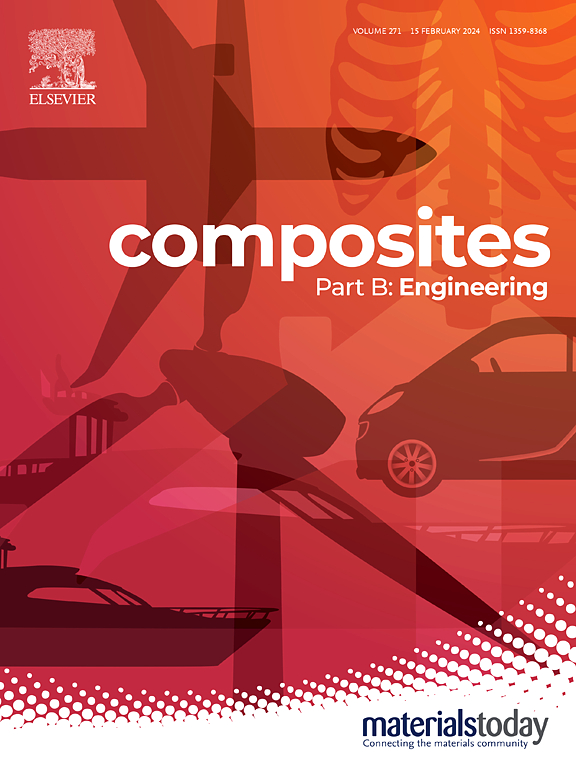具有增强光热转换的形状稳定和柔性相变材料,用于有效的热能储存
IF 12.7
1区 材料科学
Q1 ENGINEERING, MULTIDISCIPLINARY
引用次数: 0
摘要
相变材料储能系统可以有效地解决太阳能的间歇性和不均匀分布问题。但其易泄漏、固有刚性、光热转换能力差等缺点极大地限制了其实际应用。本文通过将聚氧化物(PEO)和聚乙二醇(PEG)的混合物浸渍在墨鱼墨水(CI)黑色素修饰的三聚氰胺泡沫(MF)中,制备了一种具有热致柔韧性和优异光热转换效率的新型形状稳定复合PCMs。为了提高其长期稳定性,在其表面涂覆了聚二甲基硅氧烷(PDMS)物理屏障。最后,成功制备了一系列具有不同CI浓度的创新型PEO/PEG@CI/MF-PDMS (PPCMP) PCMs。PPCMP复合pcm在80℃下具有高质量的保留率(94.39 - 97.45%),在加热或光照下具有良好的柔韧性,表明其具有优异的防泄漏性能和热致柔韧性。ci衍生黑色素的掺入使PPCMP复合PCMs具有良好的光热转换效率(83.26 - 93.67%)。更重要的是,优化后的PPCMP复合材料具有令人满意的熔融焓(>160 J/g)和较高的焓效率(> 80%)。此外,PDMS涂层赋予复合材料优异的疏水性(WCA>100°),PPCMP在100°C以下表现出热稳定性和多次循环后的可靠性。基于上述优点,本工作为构建具有良好光热转换和能量存储性能的形状稳定和柔性pcm提供了一个有前景的策略,可用于个人热管理和柔性电子的实际应用。本文章由计算机程序翻译,如有差异,请以英文原文为准。

Shape-stabilized and flexible phase change materials with enhanced photothermal conversion for efficient thermal energy storage
Thermal energy storage (TES) systems with phase change materials (PCMs) can efficiently address the intermittency and uneven distribution of solar energy. However, easy leakage, inherent rigidity, and poor photothermal conversion capacity greatly limits their practical utilization. Herein, a novel shape-stabilized composite PCMs with heat-induced flexibility and excellent photothermal conversion efficiency was prepared by impregnating a mixture of polyethylene oxide (PEO) and polyethylene glycol (PEG) into cuttlefish ink (CI) melanin decorated melamine foam (MF). To promote its long-term stability, a physical barrier of polydimethylsiloxane (PDMS) coating was applied to its surface. Finally, a series of innovative PEO/PEG@CI/MF-PDMS (PPCMP) PCMs with different concentrations of CI were successfully fabricated. The PPCMP composite PCMs possess high quality retention (94.39–97.45 %) when heated at 80 °C and flexibility when heated or light irradiated, indicating their excellent anti-leakage performance and heat-induced flexibility. And the incorporation of CI-derived melanin has endowed PPCMP composite PCMs with remarkable photothermal conversion efficiencies (83.26–93.67 %) due to its wide light absorption. More importantly, the optimized PPCMP composite exhibits a satisfactory melting enthalpy (>160 J/g) and high enthalpy efficiency (>80 %). Moreover, PDMS coating imparts the composites with outstanding hydrophobicity (WCA>100°), and PPCMP demonstrates thermal stability below 100 °C and reliability after multiple cycles. Based on the above merits, this work offers a prospective strategy for constructing shape-stabilized and flexible PCMs with excellent photothermal conversion and energy storage performance for practical applications in personal thermal management and flexible electronics.
求助全文
通过发布文献求助,成功后即可免费获取论文全文。
去求助
来源期刊

Composites Part B: Engineering
工程技术-材料科学:复合
CiteScore
24.40
自引率
11.50%
发文量
784
审稿时长
21 days
期刊介绍:
Composites Part B: Engineering is a journal that publishes impactful research of high quality on composite materials. This research is supported by fundamental mechanics and materials science and engineering approaches. The targeted research can cover a wide range of length scales, ranging from nano to micro and meso, and even to the full product and structure level. The journal specifically focuses on engineering applications that involve high performance composites. These applications can range from low volume and high cost to high volume and low cost composite development.
The main goal of the journal is to provide a platform for the prompt publication of original and high quality research. The emphasis is on design, development, modeling, validation, and manufacturing of engineering details and concepts. The journal welcomes both basic research papers and proposals for review articles. Authors are encouraged to address challenges across various application areas. These areas include, but are not limited to, aerospace, automotive, and other surface transportation. The journal also covers energy-related applications, with a focus on renewable energy. Other application areas include infrastructure, off-shore and maritime projects, health care technology, and recreational products.
 求助内容:
求助内容: 应助结果提醒方式:
应助结果提醒方式:


